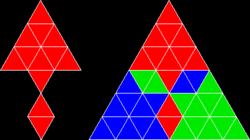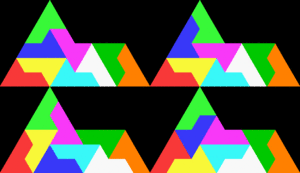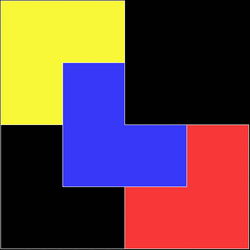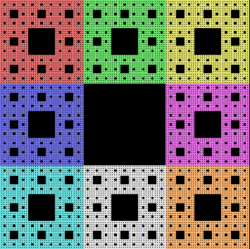Rep-tile

In the geometry of tessellations, a rep-tile or reptile is a shape that can be dissected into smaller copies of the same shape. The term was coined as a pun on animal reptiles by recreational mathematician Solomon W. Golomb and popularized by Martin Gardner in his "Mathematical Games" column in the May 1963 issue of Scientific American.[1] In 2012 a generalization of rep-tiles called self-tiling tile sets was introduced by Lee Sallows in Mathematics Magazine.[2]

Terminology

A rep-tile is labelled rep-n if the dissection uses n copies. Such a shape necessarily forms the prototile for a tiling of the plane, in many cases an aperiodic tiling. A rep-tile dissection using different sizes of the original shape is called an irregular rep-tile or irreptile. If the dissection uses n copies, the shape is said to be irrep-n. If all these sub-tiles are of different sizes then the tiling is additionally described as perfect. A shape that is rep-n or irrep-n is trivially also irrep-(kn − k + n) for any k > 1, by replacing the smallest tile in the rep-n dissection by n even smaller tiles. The order of a shape, whether using rep-tiles or irrep-tiles is the smallest possible number of tiles which will suffice.[3]
Examples

Every square, rectangle, parallelogram, rhombus, or triangle is rep-4. The sphinx hexiamond (illustrated above) is rep-4 and rep-9, and is one of few known self-replicating pentagons. The Gosper island is rep-7. The Koch snowflake is irrep-7: six small snowflakes of the same size, together with another snowflake with three times the area of the smaller ones, can combine to form a single larger snowflake.
A right triangle with side lengths in the ratio 1:2 is rep-5, and its rep-5 dissection forms the basis of the aperiodic pinwheel tiling. By Pythagoras' theorem, the hypotenuse, or sloping side of the rep-5 triangle, has a length of √5.
The international standard ISO 216 defines sizes of paper sheets using the √2, in which the long side of a rectangular sheet of paper is the square root of two times the short side of the paper. Rectangles in this shape are rep-2. A rectangle (or parallelogram) is rep-n if its aspect ratio is √n:1. An isosceles right triangle is also rep-2.
Rep-tiles and symmetry
Some rep-tiles, like the square and equilateral triangle, are symmetrical and remain identical when reflected in a mirror. Others, like the sphinx, are asymmetrical and exist in two distinct forms related by mirror-reflection. Dissection of the sphinx and some other asymmetric rep-tiles requires use of both the original shape and its mirror-image.
Rep-tiles and polyforms
Some rep-tiles are based on polyforms like polyiamonds and polyominoes, or shapes created by laying equilateral triangles and squares edge-to-edge.
Squares
If a polyomino is rectifiable, that is, able to tile a rectangle, then it will also be a rep-tile, because the rectangle will have an integer side length ratio and will thus tile a square. This can be seen in the octominoes, which are created from eight squares. Two copies of some octominoes will tile a square; therefore these octominoes are also rep-16 rep-tiles.

Four copies of some nonominoes and nonakings will tile a square, therefore these polyforms are also rep-36 rep-tiles.

Equilateral triangles
Similarly, if a polyiamond tiles an equilateral triangle, it will also be a rep-tile.

 |
 |
Right triangles
A right triangle is a triangle containing one right angle of 90°. Two particular forms of right triangle have attracted the attention of rep-tile researchers, the 45°-90°-45° triangle and the 30°-60°-90° triangle.
45°-90°-45° triangles
Polyforms based on isosceles right triangles, with sides in the ratio 1 : 1 : √2, are known as polyabolos. An infinite number of them are rep-tiles. Indeed, the simplest of all rep-tiles is a single isosceles right triangle. It is rep-2 when divided by a single line bisecting the right angle to the hypotenuse. Rep-2 rep-tiles are also rep-2n and the rep-4,8,16+ triangles yield further rep-tiles. These are found by discarding half of the sub-copies and permutating the remainder until they are mirror-symmetrical within a right triangle. In other words, two copies will tile a right triangle. One of these new rep-tiles is reminiscent of the fish formed from three equilateral triangles.


30°-60°-90° triangles
Polyforms based on 30°-60°-90° right triangles, with sides in the ratio 1 : √3 : 2, are known as polydrafters. Some are identical to polyminoes and polyiamonds, others are distinct.[4]
| File:Tridrafter as triangles.gif | File:Tridrafter.gif |
| File:Tetradrafter as triangles.gif | File:Tetradrafter.gif |
| File:Hexadrafter2 as triangles.gif |  |
Multiple and variant rep-tilings
Many of the common rep-tiles are rep-n2 for all positive integer values of n. In particular this is true for three trapezoids including the one formed from three equilateral triangles, for three axis-parallel hexagons (the L-tromino, L-tetromino, and P-pentomino), and the sphinx hexiamond.[5] In addition, many rep-tiles, particularly those with higher rep-n, can be self-tiled in different ways. For example, the rep-9 L-tetramino has at least fourteen different rep-tilings. The rep-9 sphinx hexiamond can also be tiled in different ways.
 |
 |
Rep-tiles with infinite sides

The most familiar rep-tiles are polygons with a finite number of sides, but some shapes with an infinite number of sides can also be rep-tiles. For example, the teragonic triangle, or horned triangle, is rep-4. It is also an example of a fractal rep-tile.
Pentagonal rep-tiles
Triangular and quadrilateral (four-sided) rep-tiles are common, but pentagonal rep-tiles are rare. For a long time, the sphinx was widely believed to be the only example known, but the Germany /New-Zealand mathematician Karl Scherer and the American mathematician George Sicherman have found more examples, including a double-pyramid and an elongated version of the sphinx. These pentagonal rep-tiles are illustrated on the Math Magic pages overseen by the American mathematician Erich Friedman.[6] However, the sphinx and its extended versions are the only known pentagons that can be rep-tiled with equal copies. See Clarke's Reptile pages.
 |
Rep-tiles and fractals
Rep-tiles as fractals
Rep-tiles can be used to create fractals, or shapes that are self-similar at smaller and smaller scales. A rep-tile fractal is formed by subdividing the rep-tile, removing one or more copies of the subdivided shape, and then continuing recursively. For instance, the Sierpinski carpet is formed in this way from a rep-tiling of a square into 27 smaller squares, and the Sierpinski triangle is formed from a rep-tiling of an equilateral triangle into four smaller triangles. When one sub-copy is discarded, a rep-4 L-triomino can be used to create four fractals, two of which are identical except for orientation.
 |
 |
 |
 |
Fractals as rep-tiles
Because fractals are often self-similar on smaller and smaller scales, many may be decomposed into copies of themselves like a rep-tile. However, if the fractal has an empty interior, this decomposition may not lead to a tiling of the entire plane. For example, the Sierpinski triangle is rep-3, tiled with three copies of itself, and the Sierpinski carpet is rep-8, tiled with eight copies of itself, but repetition of these decompositions does not form a tiling. On the other hand, the dragon curve is a space-filling curve with a non-empty interior; it is rep-4, and does form a tiling. Similarly, the Gosper island is rep-7, formed from the space-filling Gosper curve, and again forms a tiling.
By construction, any fractal defined by an iterated function system of n contracting maps of the same ratio is rep-n.
Infinite tiling
Among regular polygons, only the triangle and square can be dissected into smaller equally sized copies of themselves. However, a regular hexagon can be dissected into six equilateral triangles, each of which can be dissected into a regular hexagon and three more equilateral triangles. This is the basis for an infinite tiling of the hexagon with hexagons. The hexagon is therefore an irrep-∞ or irrep-infinity irreptile.
-
Regular hexagon tiled with infinite copies of itself
-
Fractal elongated Koch snowflake (Siamese) tiled with infinite copies of itself[7]
See also
- Mosaic
- Self-replication
- Self-tiling tile set
- Reptiles (M. C. Escher)
Notes
- ↑ A Gardner's Dozen—Martin's Scientific American Cover Stories
- ↑ Sallows (2012).
- ↑ Gardner (2001).
- ↑ Polydrafter Irreptiling
- ↑ Niţică (2003).
- ↑ Math Magic, Problem of the Month (October 2002)
- ↑ Pietrocola, Giorgio (2005). "Tartapelago. Arte tassellazione". http://www.maecla.it/tartapelago/frattali/indexfiocchi.htm.
References
- "Rep-Tiles", The Colossal Book of Mathematics: Classic Puzzles, Paradoxes, and Problems, New York: W. W. Norton, 2001, pp. 46–58
- Gardner, M. (1991), "Chapter 19: Rep-Tiles, Replicating Figures on the Plane", The Unexpected Hanging and Other Mathematical Diversions, Chicago, IL: Chicago University Press, pp. 222–233
- Langford, C. D. (1940), "Uses of a Geometric Puzzle", The Mathematical Gazette 24 (260): 209–211, doi:10.2307/3605717
- Niţică, Viorel (2003), "Rep-tiles revisited", MASS selecta, Providence, RI: American Mathematical Society, pp. 205–217
- Sallows, Lee (2012), "On self-tiling tile sets", Mathematics Magazine 85 (5): 323–333, doi:10.4169/math.mag.85.5.323
- Scherer, Karl (1987), A Puzzling Journey to the Reptiles and Related Animals
- Wells, D. (1991), The Penguin Dictionary of Curious and Interesting Geometry, London: Penguin, pp. 213–214
External links
Rep-tiles
- Mathematics Centre Sphinx Album: http://mathematicscentre.com/taskcentre/sphinx.htm
- Clarke, A. L. "Reptiles." http://www.recmath.com/PolyPages/PolyPages/Reptiles.htm.
- Weisstein, Eric W.. "Rep-Tile". http://mathworld.wolfram.com/Rep-Tile.html.
- http://www.uwgb.edu/dutchs/symmetry/reptile1.htm (1999)
- IFStile - program for finding rep-tiles: https://ifstile.com
Irrep-tiles
 |




![Fractal elongated Koch snowflake (Siamese) tiled with infinite copies of itself[7]](/wiki/images/thumb/2/29/Frattale_infinito_rep-tile.gif/200px-Frattale_infinito_rep-tile.gif)


